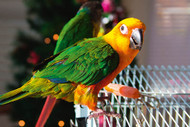All I Want for Christmas is My Two New Wings
Posted by African Grey Parrot Wings, Emergency Vet, Parrot Health, Parrot Rescue on 11/4/2025
Avian Veterinary Services tell the story of an African Grey who had work on their wings.
Budge
We first met Budge, an African Grey Parrot when he arrived at the clinic with a broken and bleeding beak tip following an unfortunate crash landing.
The reason for this incident, which had been one of many recently, was that a couple of years earlier, prior to being rescued by his current owners Ann-Marie and John Dean of Cliviger, Budge had been severely wing clipped with all flight feathers from both wings cut off.
He had technically been grounded ever since but had never really come to terms with this fact and continually attempted to fly, often ending with a bump!
In most cases, clipped feathers moult the following year and are replaced by new ones however with such a severe clip leaving only small 'stumps', experience has shown that these are very slow, or may even never be replaced. No one really knows why, but the remains of the feather may simply not have sufficient weight or force upon it to encourage it to drop.
An additional issue is that new, developing feathers have a temporary blood supply inside the shaft which 'feeds' the growing feather. The normal sequence of moulting ensures that any emerging 'blood feathers', as they are known, are supported on either side and therefore protected by 'last years' feathers.
Feathers
In a clipped bird such delicate feathers don't have this support and as such are prone to trauma occasionally resulting in life threatening haemorrhage. Budges owners were extremely keen to have him flighted but during his time in their care, he had only ever moulted one feather and so at this point it was becoming extremely unlikely this was going to happen of its own accord.
The options we had were to (a) 'pluck' the clipped stumps under anaesthesia which would hopefully encourage new growth. However, plucking the stumps can actually damage the feather follicles preventing normal growth.
Also in Budges case due to the sheer number involved this would be a painful process resulting in approximately 20 fragile blood feathers growing in at once which we felt was asking for trouble giving Budges 'Kamikaze' nature.
A preferred plan B in this case was to 'transplant' some donor feathers (previously moulted feathers from another grey Parrot of his size) into his existing stumps via a procedure called imping.
Imping is a technique that has been used by falconers for centuries to repair their hawks' feathers that may have been damaged during a hunt.
Procedure
This procedure involves trimming the damaged or clipped feather stump, finding a feather to match and using a carved wooden or carbon fibre 'peg' glued into the hollow shaft of the feather to secure it.
If performed correctly such imped feathers are preened in and treated as their own by the bird until they moult out as normal the following season.
Since he had fully recovered from his beak injury we decided that 'imping' was his best chance of regaining flight and preventing further injury. We contacted Greg Glendell, a renowned Parrot behaviourist, as he operates a feather donor service where owners send him their Parrot's moulted feathers and he organises them into full sets for imping purposes.
From experience this is a skill in itself, with one feather looking very much like another but having very subtle differences that tell him exactly where on the bird they came from. This is extremely important, as for example due to slight differences in shape the outer flight feather will only fit into this particular stump, and birds hate having a 'wonky' feather and will actually remove it if they don't think it's right!
New wings
We received two full sets of primaries in the post the very next day and with Budge under anaesthesia, we set about repairing the damaged wing. The procedure which took about an hour and a half went without a hitch and for the first time in 2 years Budge is now sporting a fine new set of wings and is once again able to take to the air which fingers crossed will put an end to his belly flops!
If you would like any further information on this procedure or if you would like to donate any of your Parrot's moulted feathers to Greg's feather bank please do not hesitate to contact us at the clinic on 01606 350 410 or visit our website www.avianveterinaryservices.co.uk.
Find the nearest avian vet to you here.




